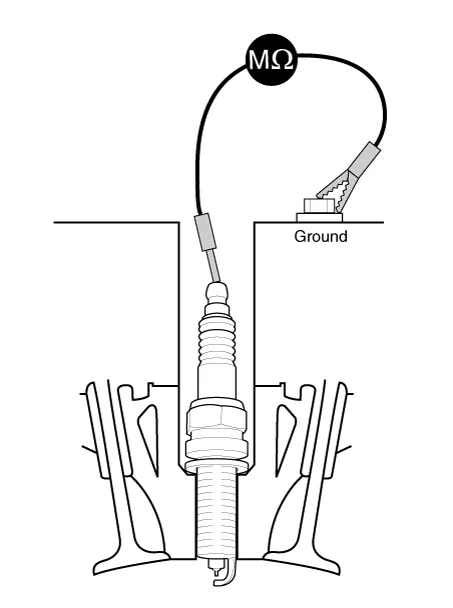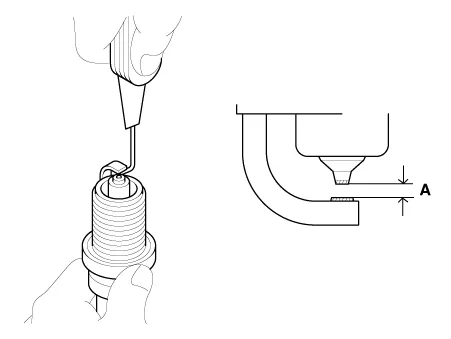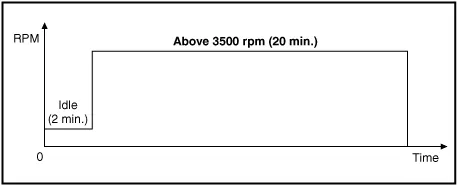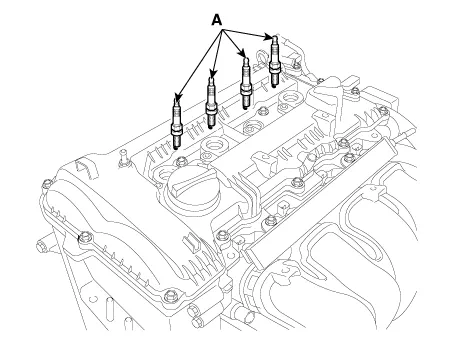Kia Optima DL3: Ignition System / Spark Plug
Description and operation
| Description |
A spark plug is a device for delivering electric current from an ignition system to the combustion chamber of a spark-ignition engine to ignite the compressed fuel/air mixture therein by means of an electric spark, while containing combustion pressure within the engine. A spark plug has a metal threaded shell, electrically isolated from a central electrode by a porcelain insulator.
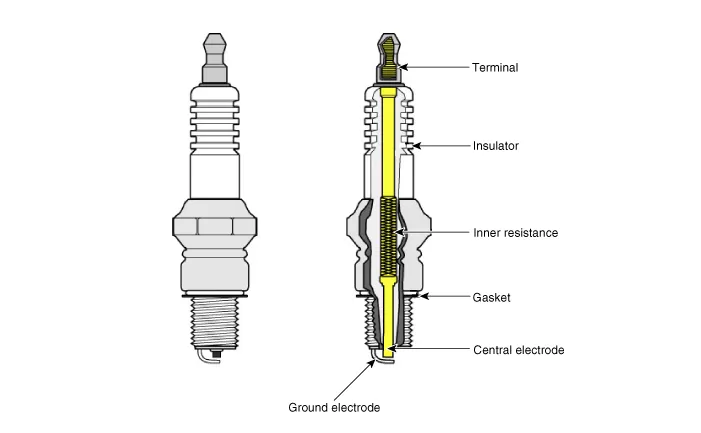
Specifications
| Specification |
|
Item |
Specification |
|
|
Type |
UNLEADED |
SILZKR7B11 |
|
LEADED |
SILZKR7B8 |
|
|
Gap |
UNLEADED |
1.0 - 1.1 mm (0.0393 - 0.0433 in.) |
|
LEADED |
0.7 - 0.8 mm (0.0275 - 0.0314 in.) |
|
Repair procedures
| Inspection |
| [On vehicle inspection] |
| 1. |
Accelerate the engine to about 3,000 rpm 3 times or more. |
| 2. |
Remove the spark plug. |
| 3. |
Check the spark plug visually. If the electrode is dry, the spark plug is normal. If the electrode is wet, check the damage and electrode gap as below. |
| [Component Inspection] |
| 1. |
Check the spark plug for any damage on its thread and insulator. If there is damage, replace the spark plug. |
| 2. |
Check the electrode. Measure the insulation resistance with an ohmmeter. If the resistance is less than the specified value, adjust the electrode gap.
|
| 3. |
Check the spark plug electrode gap. If the gap is greater than the maximum, replace the spark plug.
|
| Cleaning |
The combustion temporarily becomes unstable, due to the aged fuel and the carbon deposits accumulated on the spark plug(s) after long-term storage.
| [1st Method] |
| 1. |
Start the engine and keep the engine running at idle for 2 minutes. |
| 2. |
Step on the accelerator pedal and hold it steady at 4500 rpm with the shift lever in N position to warm up the engine until the temperature of the engine coolant reaches 80°C. |
| 3. |
Keep the engine running at 2500-3000 rpm in the N position for 15 minutes.
|
| [2nd Method] |
|
| 1. |
Start the engine and keep the engine running at idle for 2 minutes. |
| 2. |
Drive the vehicle for over 20 minutes, keeping the engine speed above 3500 rpm.
|
| Removal |
| 1. |
Remove the ignition coil. (Refer to Ignition System - "Ignition Coil") |
| 2. |
Using a spark plug wrench, remove the spark plug (A).
|
| Installation |
| 1. |
Install in the reverse order of removal. |
Description and operation Description An ignition coil is an induction coil in an engine's ignition system which transforms the battery's low voltage to the high voltage needed to create an electric spark in the spark plugs to ignite the fuel.
Components and components location Components ① ECM ② Battery ③ Alternator ④ Starter ⑤ Instrument Cluster ⑥ Ignition switch or start/stop button ⑦ Battery sensor ⑧ Hood switch Description and operation Description The charging system included a battery, an alternator with a built-in regulator, and the charging indicator light and wire.
Other information:
Kia Optima DL3 2019-2025 Service and Repair Manual: In-car Sensor
Description and operation Description The In-car air temperature sensor is built in the heater & A/C control unit. The sensor contains a thermistor which measures the temperature of the inside. The signal decided by the resistance value which changes in accordance with perceived inside temperature, is delivered to heater co
Kia Optima DL3 2019-2025 Service and Repair Manual: Climate Control Air Filter
Description and operation Description The climate control air filter is located in the blower unit. It eliminates foreign materials and odor. The particle filter performs a role as an odor filter as well as a conventional dust filter to ensure comfortable interior environment.
Categories
- Manuals Home
- Kia Optima Owners Manual
- Kia Optima Service Manual
- Front Door Outside Handle
- What to do in an emergency
- Engine Mechanical System
- New on site
- Most important about car

